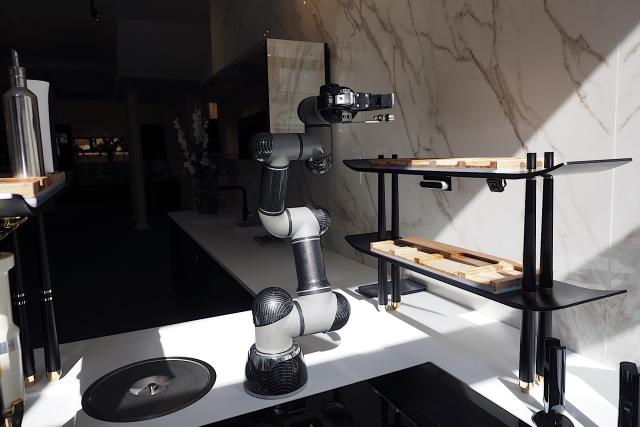In the upscale district of London’s W1, where luxury shopping meets elite dining, a new venture is seeking to revolutionize the way we cook. Moley Robotics is at the forefront of this culinary innovation, offering a blend of high-end kitchen design and robotic cooking technology that aims to simplify meal preparation for those with deep pockets and little time.
The Vision Behind Moley Robotics
Founded by Dr. Mark Oleynik, Moley Robotics combines elements of a showroom and a robotics lab, showcasing its flagship product, the X-AiR robot arm. This high-tech device is designed to automate cooking, allowing users to enjoy fresh, healthy meals without the hassle of traditional meal prep. Oleynik’s inspiration stems from a desire to promote healthier eating habits, moving away from processed and reheated foods that are common in busy lifestyles. By automating the cooking process, Moley aims to make home-cooked meals more accessible and less reliant on unhealthy convenience foods.
The showroom features three demo kitchens and a variety of luxury materials, showcasing how the robot can fit into an extravagant kitchen setup. At the heart of the operation is the X-AiR robot, which has its own cooktop and can be programmed to prepare various recipes, enhancing the overall dining experience.
The Cooking Process
One of the standout features of the X-AiR is its ability to perform cooking tasks with precision. The robot follows a recipe that has been tailored to suit its one-armed design, adapting traditional cooking techniques for automation. The in-house chef, James Taylor, works to ensure that recipes are suitable for the robot, which learns by observing human chefs prepare the same dishes.
During a demonstration, I witnessed the robot preparing an Asian Tofu Sauté, using a recipe developed in collaboration with the SHA Wellness Clinic. Ingredients were prepped in advance and placed in designated pots. Users need to inform the system where each ingredient is located, utilizing a visual layout that helps the robot identify where to find each component. Once programmed, the X-AiR begins its performance, turning on the cooktop and carefully adding ingredients as directed by the recipe.
While the robot’s movements are impressive, it does lack the finesse of a human cook. For instance, its stirring technique is less thorough than what a person would do, merely pushing the mixture back and forth rather than fully incorporating ingredients. This limitation highlights the challenge of automating tasks that require nuanced human judgment.
Price Point and Market Position
The X-AiR is not just a kitchen appliance; it’s a luxury item with a starting price of £80,000 (approximately $105,000). This hefty price tag reflects both the technology involved and the high-end market it targets. Despite not yet having installed a single unit, Moley has already secured pre-orders from interested customers. The robot does not come equipped with advanced sensory technology, relying instead on a memory-based system to navigate its environment. While this may limit its adaptability, it also simplifies the overall design and reduces costs.
Oleynik acknowledges that the original concept featured a two-armed robot that could move on tracks, but the high cost made it impractical for the intended market. By streamlining the design to a single-arm model and sourcing the robotic components from Universal Robots, Moley was able to bring the price down to a somewhat more manageable level for affluent consumers.
Limitations and Challenges
While the technology is impressive, several limitations come with it. For example, the X-AiR can only prepare a limited number of portions—between eight and ten—making it less suitable for larger gatherings. Additionally, the robot cannot improvise or adjust recipes based on ingredient availability, requiring users to have the exact components on hand. This rigidity may not appeal to home cooks who enjoy experimenting with seasonal ingredients.
Furthermore, the X-AiR cannot handle tasks like peeling or chopping vegetables, which many would argue are the less enjoyable parts of cooking. Oleynik has expressed hope for future advancements in these areas, but current technology does not allow for the safe automation of tasks involving sharp objects.
Culinary Results
Despite my personal aversion to tofu, I found the dish prepared by the robot surprisingly delightful. The tofu had a pleasing texture and flavor, harmonizing well with the accompanying vegetables. This experience exemplifies the potential of Moley Robotics to produce quality meals, even if the cooking process lacks the personal touch of a human chef.
The Future of Robotic Cooking
Oleynik envisions a future where these robots can serve not only affluent households but also businesses such as hotels and airlines. The concept is to provide fresh meals in environments where hiring a full-time chef is economically unfeasible. The X-AiR could serve in places like care homes or remote service stations, delivering nutritious meals without the overhead of traditional cooking staff.
While there are undoubtedly logistical challenges, including the need for human oversight in preparing ingredients and serving food, Oleynik is confident that businesses can see a return on investment within a year. The potential for cost savings and efficiency could appeal to many sectors.
Conclusion
Moley Robotics is carving a niche in the intersection of luxury, technology, and culinary arts. While the X-AiR robot arm may not replace human chefs entirely, it offers a glimpse into a future where cooking is automated and healthful meals are more accessible. With its innovative approach and commitment to quality, Moley Robotics is poised to attract a clientele that values both technology and gourmet cuisine. As the market for automated cooking solutions continues to evolve, it will be fascinating to see how this technology shapes the future of home cooking and dining experiences.

